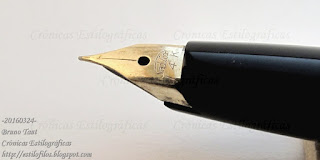These are the facts:
1. The Montblanc-Fountain Pen Network (FPN) controversy (::1::, ::2::). Back in January, some FPN members published pictures of the not yet released Montblanc William Shakespeare model. Apparently, those pictures had been leaked by some Montblanc shops. Anyway, Montblanc complained before the administrators of FPN, who decided to remove the related threads.
Some controversy (see ::1:: and ::2::, especially the comment sections), mostly outside the FPN, followed, but that is not the issue here. What matters now is that Montblanc felt the need to react instead of ignoring the whole issue or resolving it internally by disciplining those who leaked the information.
2. Brown and the trolls. Well-known blogger and pen connoisseur SBRE Brown complained on his blog about the personal attacks he had been receiving recently through the comment section of his videos in YouTube. Brown expressed his surprise for what he considered a change in the community that he had thought as exemplary.
Again, Brown’s and other’s (Armstrong of The Pen Habit, Deans of Fountain Pen Economics, thread on Reddit, thread on Fountain Pen Geeks forum, etc.) comments are secondary to this argument. The relevant detail is that now we see people who take time and effort to express their dislike about something pen related.
I understand this phenomenon as an indication of an increased popularity of those videos. More viewers mean more exposure also on those lists of suggested videos on YouTube. And more viewers imply more probabilities of undesired personalities, of trolls with nothing of interest to say. In any case, the bottom line is a larger number of people exposed to pens.
3. Delta and Marte Modena (The best summary I have found is this link by Pedro Haddock: http://elpajareteorquidiado.blogspot.jp/2016/04/el-asunto-delta.html). Italian brand Delta has decided to market some of its products exclusively through an online retailer—Marte Modena. This decision has alienated the traditional retailers as Delta is focusing on online customers, usually more acquainted with their products than the occasional customer of a brick and mortar shop.
4. Two more details, even if minor to the whole picture. Ian Hedley, of Pen! Paper! Pencils!, took the effort of writing a letter to Pilot UK to ask about Pilot’s import and pricing policies, and Pilot responded with detailed information (or detailed excuses). And in an operation of public relations, Pilot USA invited the Goulets for a visit to their facilities in Florida in November of 2015.
Both cases illustrate the importance given by Pilot to the online scene. And this is a new development.
So, what do all those facts mean?
All in all, they could be interpreted along the line of the pen community becoming larger and stronger. I have always argued that we, stylophiles, were a small group, economically weak, almost irrelevant in the economic balance of pen makers when compared to the group of occasional pen buyers. In other words, no matter how many pens we stylophiles could buy, we were no match to the volume of new fountain pens acquired by those occasional consumers.
But that imbalance might be changing. We might have become more attractive to brands like Montblanc, Delta and Pilot in the examples here described.
If my interpretation was true, the consequences would be very interesting. The business model of pen makers would evolve to cater some of our obsessions and cravings. Our opinions on fountain pens would, in fact, matter. Maybe then, the general frustration about the limited availability of nib points of most brands could be solved, for instance.
But, of course, this could just be wishful thinking.
Daiso Chinese pen with Mochizuki cross nib – unknown blue ink
Bruno Taut
Nakano, April 15th 2016
etiquetas: Montblanc, Delta, Pilot, mercado, fora, metabitácora
Bruno Taut
Nakano, April 15th 2016
etiquetas: Montblanc, Delta, Pilot, mercado, fora, metabitácora












































